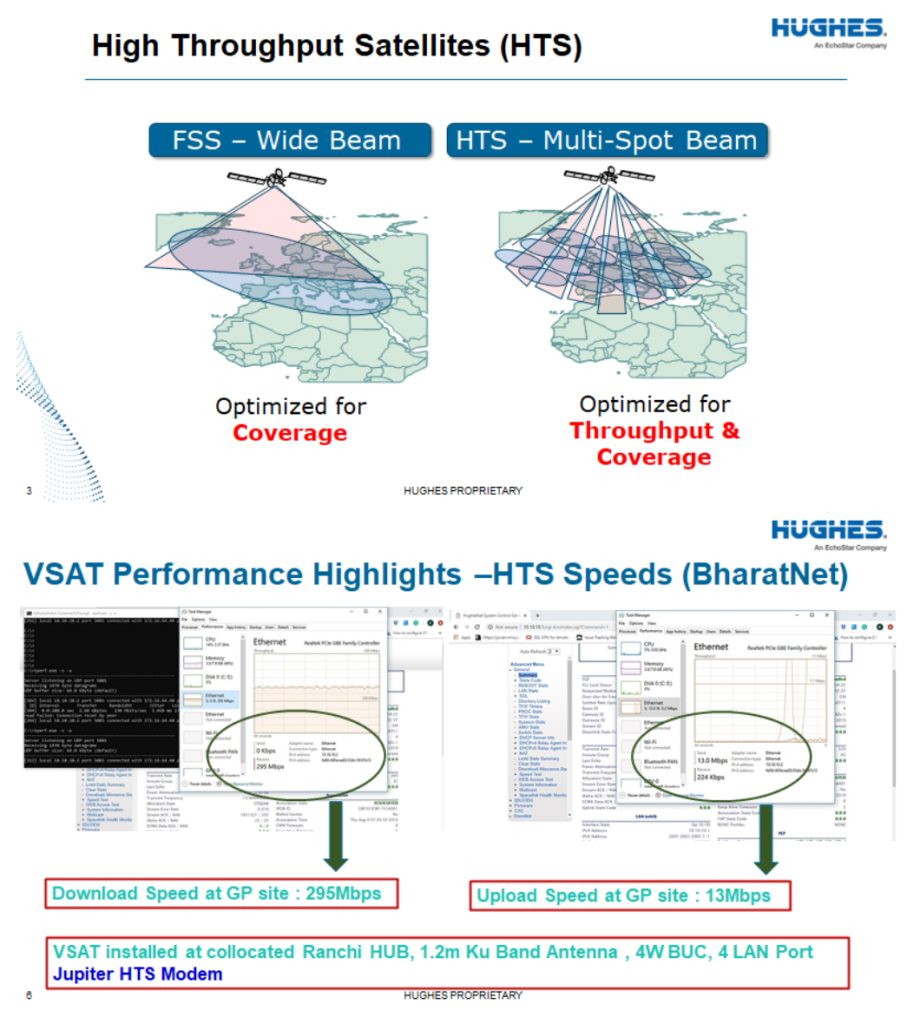
Hughes Communications India Private Limited (HCI), a supplier of broadband satellite and managed network services, launched India’s first HTS broadband service.
Hughes HTS broadband service combines Ku-band capacity from ISRO’s GSAT-11 and GSAT-29 satellites with Hughes Jupiter Platform ground technology to bring high-speed broadband across India, especially in remote places.
The service connects both enterprise and government networks and gives small businesses satellite Internet, Wi-Fi hotspots, SD-WAN solutions, and mobile backhaul. Earlier, London’s OneWeb and Hughes were partners for Low Earth Orbit satellite broadband service to India.
HCI provides satellite broadband to more than 200,000 government and business sites in India. This helps businesses and government programs. The Hughes JUPITER System is the standard around the world for both High-Throughput and regular satellites.
The JUPITER System gateways, VSATs, and operations and business support systems provide high-performance cellular backhaul, community Wi-Fi, and internet access. HTS broadband service offers optimized throughput and coverage.
The HTS satellites are different from conventional satellites as they works on 100-500 MHz range with Narrow Hight power of up to 100+ Gbps of speed. The broadband service is delivered by Power Satellites from 5X to 10X with higher uptime, which offers relatively low and consistent latency. Furthermore, it also offers bandwidth in-route (uplink), which offers 1/2/4Mbps with symmetric bandwidth.

As part of the market-leading Hughes Jupiter System, the HT2300 is a powerful, next-generation satellite terminal that supports the wideband DVB-S2X forward channel. Furthermore, the return channel uses LDPC and AIS for industry-best performance.
The HT2300 delivers up to 200 Mbps of throughput and supports bandwidth-intensive applications. The terminal has a Web-based user interface (GUI) that makes it easy to install, check the status, fix problems, and do diagnostics. Additionally, the HT2300 terminal includes a desktop chassis for home or business use.
The terminal supports dual-cable IFL, which permits an industry-standard L-band interface to the outdoor unit and operation on a wide range of frequencies with a variety of high-power BUCs. The router also features 4 GigE connections.
“HTS will play a pivotal role in extending broadband connectivity to remote locations and creating economic opportunities” says @isro chairman, Dr. S. Somnath. pic.twitter.com/HIfcUm9xMO
— Hughes India (@hughes_Ind) September 12, 2022
In support of the new service, Dr. S. Somnath, Secretary, Department of Space, and Chairman, Indian Space Research Organization said:
Thanks to the continuous efforts by the Government of India, there is growing optimism and excitement about enhancing public-private partnership in India’s space ecosystem. At ISRO we are committed to exploring and expanding the ways we can work with the private sector to help improve people’s lives and bridge the digital divide.
With the new HTS capabilities powered by ISRO satellites, we are confident that HCI will continue to deliver excellent quality satellite broadband services and further enhance the connectivity experience that accelerates India’s digital transformation. With its inherent advantages and ubiquitous nature, the new HTS service will play a pivotal role in extending broadband connectivity to the remotest locations, difficult to reach otherwise, and create economic opportunities to boost the local economy.
Commenting on the launch, Partho Banerjee, president and managing director, HCI said:
With support from ISRO, we are happy to announce the commercial launch of India’s first HTS broadband service. Available countrywide, HTS broadband from Hughes underscores our long-standing commitment to bridging the digital divide, delivering multi-megabit high-speed broadband at affordable rates.
This new broadband service will address connectivity gaps, improve network performance, and support the high bandwidth requirements of government organisations, financial companies, cellular operators, mining and energy companies, among other businesses, large and small, helping to connect India to a limitless future.
